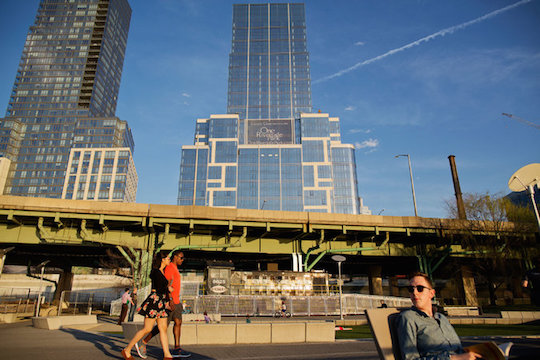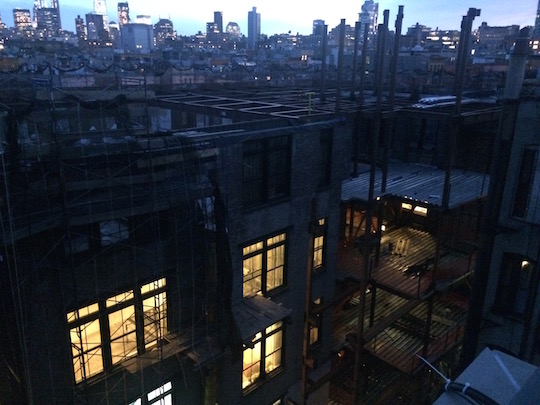A new high-rise building at Riverside Drive and West 62nd Street, excoriated for having one door for condominium owners and a separate entrance for residents of affordable housing, has attracted 88,000 applicants for its 55 low-priced units. Available to households whose income is between $30,000 and $50,000 a year, the affordable apartments rent at $1,082 for a two-bedroom and $833 for a studio. That’s a pretty sweet deal, even if you don’t get access to the gym, the pool, the private theater or the bowling alley, and even if you have to enter and exit the building through a designated “poor door.” You also don’t get to live at 50 Riverside Drive, with the quality. Instead, you live at 470 West 62nd Street—a distinction that will seem meaningless only to those who have not lived or worked on the Upper West Side.
Between 59th and 96th Streets, an avenue address1 is more prestigious. An avenue address with a low number is yet more ritzy. An apartment on Riverside Drive is classy no matter how far uptown it gets, but an address that grips the base of that majestic artery is especially arousing. To be in the 400s of a numbered street, on the other hand, is only to be far from the subway.
Not that the residents of the 219 luxury condos at 50 Riverside care about the subway. According to the Times, most of those units have sold already, some for more than $25 million. Unit 13D, a two-bedroom in which the maid’s room has been “incorporated into the kitchen,” is still available for $3.2 million. There’s also the $3,827 monthly maintenance fee, so don’t forget to transfer some money to your checking account after you make the $800,000 down payment.
That’s a lot of money, but you do get a great location and a posh address, as well as access to a pool and movie theater that poor people can’t go into. Anyone who has gone to the movies in New York appreciates the value of that amenity. But anyone who saw Selma can’t feel great about a segregated pool.
And whom, exactly, is kept out of that pool? At $50,000 a year, the high end of incomes that pass through the “poor door” of 470 W. 62nd will be just under the US median household income of $52,000. That’s the middle-class door, right there. The developers of 50 Riverside Drive built a separate entrance and incurred controversy not to protect their wealthy residents from the poor, but to protect them from workaday professionals.
I’m not sure that is an occasion for moral censure. Living in a $3 million condo whose entrance is separate from that of the median-income peasants next door is not so different from living in a nice co-op next to rental apartments. Separate doors for rich and poor affronts our sense of decency, but the rich and “poor” sections of this development also have different addresses and, it seems, occupy different structures. This split project seems to be one building in name only, and the developer appears to have combined the affordable and luxury portions only to game city housing requirements.
But what a city: where 88,000 people enter a lottery for 55 units of affordable housing, and “affordable” means available to middle-income families that want to spend 25% of their pre-tax income on rent, and the people who win that lottery will have to use a separate entrance from which they can presumably not smell the pool. I miss it terribly. But I do not miss the monster rent pressure, nor the constant reminders of how much it has changed.
In the year 2000, I was scandalized to learn my friend paid $800 a month for her half of a two-bedroom on St. Mark’s Place. That was a great location, we agreed, but $800 was absurd. At that time, I was paying $275 for my third of an awful two-bedroom in South Bushwick. I spent less on rent than anyone I knew, and it wasn’t worth it. But at least it was possible. I lived in New York City and worked at a performance art theater that paid me $19,000 a year, and I was happy.
That is not possible today, mostly because I am 37 instead of 22. Part of it, though, is that you can no longer live poor anywhere within a 40-minute subway ride of Manhattan. There are still artists in New York, but they are independently wealthy. Manhattan remains the nightlife and brunch capital of America, but I’m not sure it is still the place for literature or performance or weird art.
I don’t know, though, because I don’t live there anymore. I left town when I determined that I could write full-time if I lived anywhere else. Two weeks ago, they gutted the theater I helped build at PS 122. The organization will return to that space in summer 2016, presenting art in the same location but a radically different environment. So goes the greatest city in the world.






This reader would appreciate it if the writer’s longing for New York could be as self-effacing as his love of unpopular music here. In this post, the writer understands there is objective value in New York and that real estate valuation is reducing it. In that New York Times piece, the writer understood that his tastes are benighted and shaped by adolescence. Why should rising property values be more of an occasion for bereavement than the invention of instantly accessible music for the masses?
Seriously, Attempt #1? Maybe I’m missing some deadpan in here and am getting annoyed by a joke, but it doesn’t take much to see that the difference between streaming music and real estate is the difference between universal access and exclusive access.
Sadly, Unit 13 D now appears to be sold.
No, you got it Mike S. The difference, among others, is between universal access and exclusive access. This post does not address that economic difference, however, it is more self-interested. In the NYTimes piece I linked to, Dan wrings his hands about the erosion of exclusive access in his music scene. Technology has made it easy for everyone to find the cool bands he worked to identify, which deforms a piece of his identity. If everyone has access, he asks, how can we derive meaning from it?
Now NY’s real estate is changing access to the geographic boundaries and he’s wringing his hands again. The relationship is reversed-access is becoming constricted for the masses rather than expanded-but his response is the same; oh nooo! If no one except the rich have access to New York, how can we derive meaning from it?
His acknowledgement of adolescence and the need for (somewhat) arbitrary identity is cathartic that helps his essay work as an adult reflection on the past. I contend the same solution would work for the loss of New York as he knew it. But he doesn’t take that route in this post. If real estate prices are as systemic and inscrutable as technological innovation, why mourn the change in one but not the other? They both are hopelessly outside our hands, and the main difference is whether the masses are being enfranchised or not. That is an an economic issue, not an identity issue.